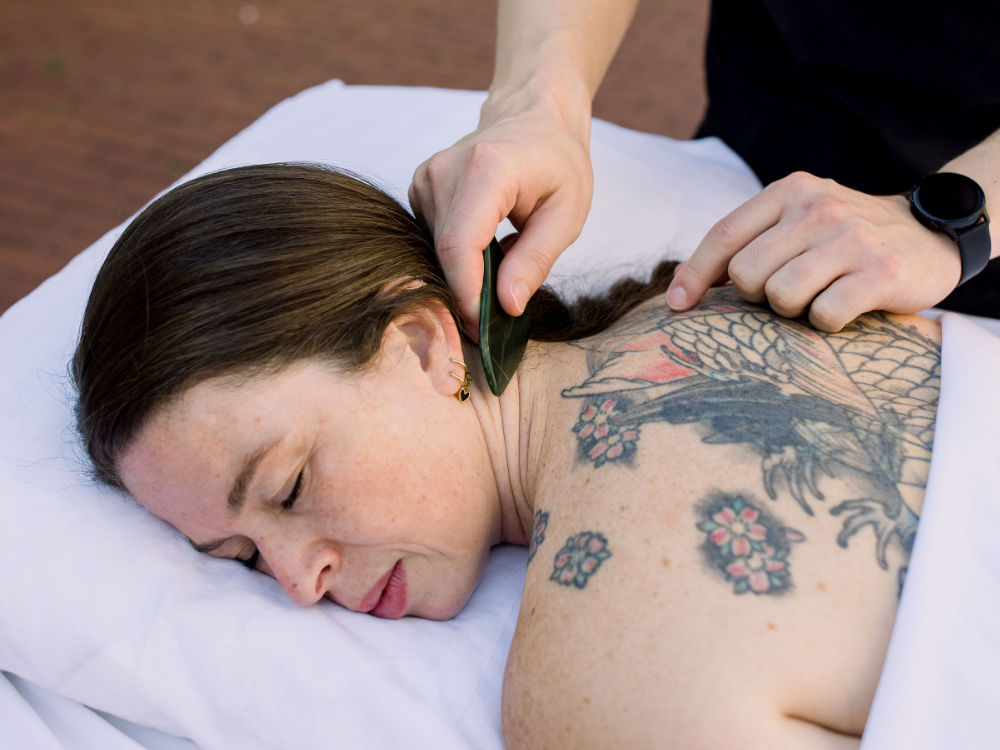Curious about Gua Sha? It’s an ancient Chinese healing method that’s been around for ages. Using a special tool to scrape your skin, Gua Sha releases toxins and boosts blood flow. Great for treating pain and other health issues. Read on to learn its history, benefits, and how it works. Plus, check out one of my favorite success stories that might just convince you to try it yourself!
Quick Links to the Sections Below
What is Gua Sha?
Gua sha is a Chinese medical technique that helps release toxins and stimulates blood flow, by scraping the skin with a round edged tool. “Gua” stands for scraping and “sha” pertains to the discoloration on the skin that resembles bright red bruising
Where did Gua Sha Originate?
Gua sha can be traced back thousands of years, utilizing rough objects such as stones, coins, and even household objects were used to perform gua sha. In Traditional Chinese medicine, gua sha would commonly be used with a Chinese soup spoon or bare hand alongside a massage oil or balm. Gua sha was not used for beauty or complexion benefits, but rather ailments like heatstroke or virus.
Because gua sha goes back thousands of years it is difficult to credit the origination of gua sha to a singular individual. Gua sha is a generationally inherited practice that has remained culturally significant due to its proven benefits.
Does Gua Sha Work?
Not only does gua sha work, it is one of the fastest ways to relieve certain types of pain. i.e. neck and shoulder pain. It is great for treating other areas of the body as well.
How Does Gua Sha Work?
Gua sha works by scraping the skin with a round, edged, tool, like a Chinese soup spoon. Scraping the skin with a tool increases the blood flow, causes blood to rise to the surface and toxins are then released into the air from your skin. No blood ever comes out of the skin.
If there are toxins in the area that we are scraping the skin will turn bright red. If there are a lot of toxins in an area the skin may turn dark red. The deeper the toxins, the longer it takes for the discoloration to fade. Sometimes the area is sore the next day and then the pain subsides by the following day.

Where on the Body Is Gua Sha Done?
The gua sha technique is typically done on the neck and shoulders because you can get into the crevices of the body easier. The more toxins, congestion, and stagnation in the area, the more tender the area. Gua Sha can be done on any part of the body for issues like headaches, colds, diabetes, stress, acute epiglottitis, frozen shoulder and of course other types of pain.
Pain is usually due to blood not flowing freely through an area of the body because of toxins. Gua Sha brings the blood to the surface of the skin, then toxins are released into the air, normal blood flow resumes and the pain is relieved.
How Often to Gua Sha?
Typically, we recommend doing gua sha no more than once a week in an area or after the “sha” has completely gone away. The “sha” is the reddish spots that appear if there is toxicity in the area.
The bright red bruising on the skin will fade immediately or in a couple of days depending on how long you have had the problem. The longer it takes for the bruising to go away the deeper the toxins are in the body, I’ve seen discoloration last up to 10 days.
Effects of Gua Sha
During gua sha, the patient usually feels heat being released and loosening of the muscles in the area. Blood flow increases and the pain dissipates. The heat that starts to rise from the body is caused by toxins being released. Some people say it’s like a deep massage that you don’t want to end. The bruising is due to broken blood vessels and this process allows new blood to form.
Benefits of Gua Sha
The biggest benefit of Gua Sha is the immediate pain relief that usually follows. It is also very helpful for immobility, usually the patient is able to move easier and has more range of motion during the treatment.
Just yesterday a patient told me they hadn’t been able to totally flex their arm to teach a dance class in a long time. Therapies like gua sha, can be very useful when patients can’t take medications or are afraid of needles, but are in a lot of pain.
One of My Favorite Gua Sha Case Studies
When I first started practicing acupuncture, I had a patient with a frozen shoulder and neck. Her neck was stuck, turned slightly to the left and her right arm was stuck with her hand on her chest.
She was a retired social worker who worked for years at a desk where the air blew on her all day. After years of this she woke up one day and couldn’t move her right arm. A couple of years after the arm, the neck was stuck. She had endured this for almost 10 years when I met her.
She had been to other types of doctors, but nobody was able to help her. I started with Gua Sha at the neck and then right shoulder/arm. I was able to loosen them both a little at a time after a couple of treatments. We then spent weeks strengthening her neck, shoulder and arm with acupuncture and herbs. She was so happy to be able to move her neck and arm because her son’s wedding was coming up. She was also able to drive again and her husband was happy about that.
I often use gua sha for neck and shoulder pain, but it can be used for other issues like chronic coughing left over after Covid. By using gua sha on the chest and upper back you can clear toxins from the lungs. Diabetes can also be treated with gua sha by scraping around the kidney area of the low-back.
Gua Sha Works for Powerful Healing
As you can see, gua sha is a powerful adjunct therapy to acupuncture and herbal medicine.
If you are ready to try gua sha for yourself, go ahead and schedule your appointment to be evaluated by one of our acupuncturists at our clinic in Washington, DC.



